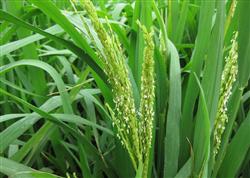What should rice heading stage medication pay attention to?

Rice heading stage should pay attention to what? Please give a detailed introduction to rice before and after heading is generally a variety of pests and diseases damage period, need to use chemical pesticides to control, but in this growth period, some pesticides are easy to cause phytotoxicity, causing undue losses, should be paid attention to. 1. Triazolone. Before heading of rice, rice blast and bacterial blight are often damaged. Triadimefon (triadimefon) is commonly used to control rice, but improper use will lead to short rice leaves and serious failure to head. 2. Diniconazole. At the early stage of rice heading, pesticides such as diniconazole 12% are commonly used to control rice false smut. If the pesticide is excessive, it is easy to have difficulty in heading, or the phenomenon that half of the ears will stop. When pesticides containing diniconazole such as Quwenxing and Heguoli were used at the break stage or the early heading stage of rice, the growth of panicle neck internode was affected, and the phenomenon of "wrapping neck" appeared, and normal heading could not be performed. III. Arsenic preparations. If arsenic is used improperly in rice, it is easy to cause seed failure or decrease in seed setting rate. 4. Azole fungicides. Imidazole fungicides should be used with caution before and after heading of rice. If not used properly, it will affect heading and filling. The compound agent of hexiconazole and validamycin, such as wensu, etc., and the single agent of propiconazole, diniconazole and thiofuramide, such as dili, gragoli, mansui, etc., generally have an effective period of more than 15 days, and have good effects in controlling rice sheath blight. It should be noted that azole fungicides such as tebuconazole, diniconazole, hexaconazole and propiconazole will inhibit the formation of gibberellin in rice, and may inhibit internode elongation when used in the upper internode of rice, especially when used in an increased amount, resulting in difficult heading and affecting rice filling and setting. 5. glyphosate. Inappropriate spraying glyphosate at rice booting stage is harmful. Incorrectly applying glyphosate to hybrid rice fields can lead to abnormal heading of rice fields and yield loss of 80~100%. The differentiation part of young panicle is easy to produce phytotoxicity, resulting in heart leaf death, young panicle deformity and other symptoms. Click for more rice cultivation technology Click for more food crop cultivation technology
- Prev

How to prevent lodging and grass damage in rice?
How to prevent lodging and grass damage in rice? Please introduce the control methods of rice, which are easy to lodging and vulnerable to grass damage. The following countermeasures should be taken: to select the right varieties and choose direct seeding rice varieties should not only have high quality, high yield and multi-resistance, but also have the characteristics of fertilizer tolerance, dwarfing and medium tillering. Mid-maturing varieties should be selected for early rice.
- Next

What if it is difficult for rice to heading?
What if it is difficult for rice to heading? What kind of medicine can be taken to solve it? It is difficult for rice to heading, or the phenomenon of neck wrapping appears. Because the rice grains wrapped in the leaf sheath can not be pollinated and fertilized in time, they will generally become empty grains, which has a great impact on the yield. There are many reasons for this phenomenon, some of which are neck-wrapped phenomenon of the variety itself.
Related
- The first cup of black tea in spring, the flavor and history of tea gardens in Kenya, Africa
- The computer can not only choose potatoes, but also grow tea rice. AI will grow winter oolong tea champion.
- It is not only the inflated tea bitten by insects, but also engraved with the four seasons tea in Beipu.
- The Oriental Beauty Tea Festival in Zhuxian County takes the stage at the weekend to experience the plus-size feast of oil tea.
- & quot; Oriental Beauty Tea & Exploration of Emei in Hsinchu, the hometown of quot;
- The new variety of strawberry "Tainong 1" dessert is the first choice with mellow aroma. Crimson gorgeous
- History of Tea in Taiwan: from Wild Inner Mountain to Export Tea Garden
- Two types of Taiwan Oriental Beauty Black Tea won the British three-Star Award for Childhood Tea Xiang Zhang Jiaqi changed from pilot to champion tea maker.
- Banana species and varieties: the planting history of Taiwan Xianren banana and dwarf banana is long, is banana disease resistant?
- Coffee planting Technology: Qianjie Coffee from Seedling to harvesting

